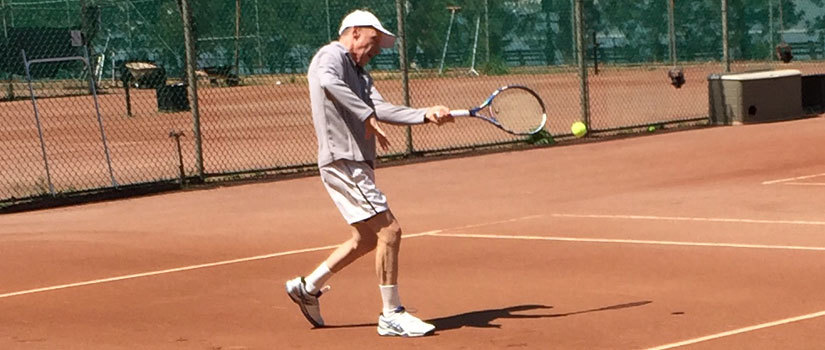A COMMITMENT TO TENNIS EXCELLENCE, LATER IN LIFE. MUCH LATER.
MJ Hanley-Goff
After spending most of four decades as a magazine editor –the last seven years as editor of The New York Times Magazine—Gerald Marzorati now devotes himself to a decidedly different, but unquestionably demanding, life of “service”—as in, being a “better than amateur, but not near-pro” tennis player.
In his early 60’s, Gerry (as he prefers to be called) began seriously training for the sport that has interested him since his youth. Marzorati’s recent memoir, Late to the Ball: Age. Learn. Fight. Love. Play Tennis. Win (Scribner, 2016) is an inspiring and entertaining account of his post-retirement exercise to master both physically and mentally, a complex game.
When Gerry began what he calls his life’s encore chapter, his coach, Kirill, was half Marzorati’s age. “I was attempting to become a serious amateur tennis player – not that I was sure what that meant, exactly,” he writes. His book chronicles both the lessons taken, the games played, the lessons learned, and the enjoyment of seeking out meaning in areas he’s never investigated before. For instance, how to navigate a return ball is much like how an outfielder would calculate the catching of a fly ball—making the rapid mental adjustments between brain and muscles to be in the right place at the right time. How much of these kinds of lessons do we already experience in life outside sports?
Marzorati continues to play on several club teams, traveling around the county a couple of times a week and “meeting a lot of guys not unlike me.” We caught up with him in between sets (well, not really, but I’ve always wanted to say that), and asked him about life after one career ends another one, of sorts, begins.
Have you always been a seeker of meaning, or did this interest start when you decided to better your tennis game?
I guess I’ve always been a searcher, in a sense. I was lucky enough — I would put it that way — to have come of age in the Sixties. It was a wonderful time to be a teenager, in that everything seemed suffused with a sense of possibility. There was fear, too — in my blue-collar New Jersey part of America, a lot of guys four, five years older had enlisted or been drafted, and were in Vietnam. Some had come back physically or emotionally damaged. But mostly there was a lot of hope and wonder and discussion with the younger of our teachers about how to change the world and change our individual selves.
Self-actualization was the buzzword. How can you find out who you really are? What you really want to do?
You say that tennis is the hardest sport, taking into account speed, endurance, hand-eye, and psychological toughness. Isn’t it fair to say that most sports require those same four traits?
I do think tennis is the hardest sport because it is a skill sport that also requires quickness, endurance, extended focus — and so much thinking and doing on the run. Also, with singles, there is the gladiatorial aspect.
So why did you decide to hone in on tennis?
I think it is the beauty of tennis that attracted me and still does, though there is little beauty to my own game. The elegance and geometry of it. Beyond the beauty, there is the gentleness of the manners and mores, that politeness, despite the physical and mental intensity. I wanted to see if I could be that person. And I think it’s true to say that I am better at that aspect of the game — a gentleman on court — than I am at actually playing.
You’ve said that when you play, you feel that time moves slowly because you are a student again?
What I feel with my tennis learning is that I am in control of a narrative of improvement, even as I approach my 65th birthday. I worked a lot last summer on my volleys and chip returns, and both are better today than they were on Memorial Day.
I love the notion of using rituals to acknowledge anxiety. Did your serving rituals help?
I think what works best for me are two things: At the end of every point I take the racquet out of my hitting hand and place it in my non-hitting hand, my right. And then I turn my back to the court and take a deep breath or two.
With all this experience, what do you suggest to the 40-and-older group to focus on as they move into the later-middle age?
I would say that on your 50th birthday, you need to start thinking about what you are going to do in your 60s and 70s. You need a plan. You need a passion for something to get better at for yourself; and you need a cause at which to work in some capacity to make the world a better place as you see it — something that is not about you, that represents an active way of giving back.
You are now the Senior Strategist at Stone Barns Center for Food & Agriculture, [a non-profit farm and educational center in Tarrytown, N.Y.] What do you do there, and have you brought any of the tennis experience to that role?
Stone Barns is where I work at my cause: Helping to change the food system so that what we grow is done more sustainably and what we eat is healthier for us. I’m a consultant to the CEO, essentially. It doesn’t really have much to do with tennis, save that she, the CEO, also happens to be a very good tennis player.
You end the book with “…there would be time enough for most everything.” What do you mean by that?
I mean that if you, like me, have the good fortune to be healthy in your early 60s, and are more or less satisfied with what you made of your life — the career, the kids — you have perhaps another 15 to 20 years to explore yourself and the world. That is a lot of time. Precious time.
MJ Hanley-Goff is a freelance writer who recently moved to Nassau County, New York, fulfilling a promise she made in her previous essay (http://roelresources.com/so-where-would-home-be-now). Author of two books, MJ conducts writing workshops throughout the metropolitan area. She can be reached at mjgoff758@gmail.com.


